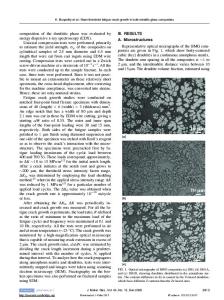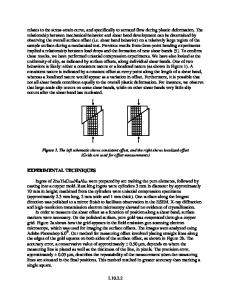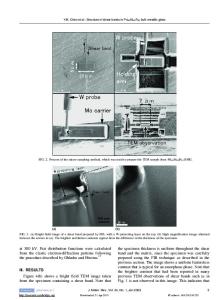Shear localization of nanoscale W in metallic glass composites
- PDF / 326,860 Bytes
- 8 Pages / 612 x 792 pts (letter) Page_size
- 112 Downloads / 344 Views
High-density tungsten/metallic glass composites were fabricated by warm extrusion of two different powders. The first powder was a physical blend of −45 m tungsten and Hf-based metallic glass powders and produced a relatively coarse distribution of tungsten particles within a continuous metallic glass matrix. The second powder was synthesized by mechanical milling the −45 m tungsten and Hf-based metallic glass powders into composite particles composed of 20–500-nm layers of tungsten and metallic glass. The amorphous structure of the starting glass powders did not change during milling. Some macroscopic plasticity during compression testing was observed due to the formation of multiple shear bands at the interface between the coarse tungsten particles and the metallic glass matrix in the composite produced from blended powders. In contrast, shear localization without a decrease in strength occurred uniformly throughout the nano-grained tungsten and metallic glass phases in the sample obtained from extruded composite powders.
I. INTRODUCTION
Bulk metallic glasses (BMGs) exhibit several favorable properties such as high yield strength, relatively low Young’s modulus, high elastic strain limit, and perfect elastic behavior at room temperature that result from their disordered atomic arrangement, which differs from conventional crystalline alloys.1,2 Despite the list of desirable characteristics, BMG undergoes catastrophic failure at room temperature due to shear localization when subjected to a compressive mechanical load.3 This lack of global plasticity due to localized shear flow has limited the application of these BMGs in many traditional applications. Because of the strong shear-localization susceptibility in BMGs, their use has also been suggested for kinetic energy penetrators (KEP). It is known that the selfsharpening behavior in depleted uranium (DU), which is commonly used for this application, is related to localized shear during high strain-rate deformation, which results in better performance when compared to tungsten heavy alloys (WHA).4 Shear localization in Zr-based BMGs, which have a large glass forming ability enabling the fabrication of bulk shapes, was reported by Bruck et al.5 These alloys were also investigated for use as
a)
Address all correspondence to this author. e-mail: [email protected] DOI: 10.1557/JMR.2006.0059 492
http://journals.cambridge.org
penetrator materials, but the density of monolithic Zrbased BMG is only ∼6.7 g/cm3, which is too low for penetrator applications. Therefore, it has been suggested that introducing a high-density metal (e.g., W) into a BMG matrix would achieve the required combination of density and deformation behavior to compete with DU.6,7 However, the use of the lower-density Zr-based BMG alloys limits the maximum densities of composites, while the use of body-centered cubic (bcc) metals to increase the density (especially W) presents another problem as they are unfavorably resistant to shear localization because of their strong strain-rate sensitivity
Data Loading...











